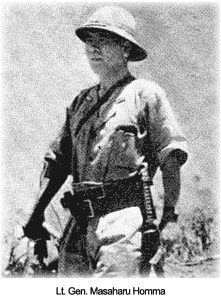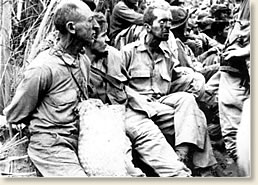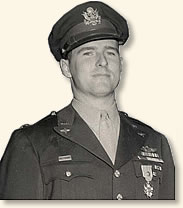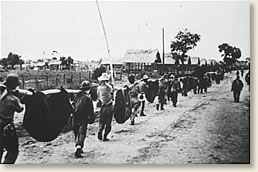DEATH MARCH History
World War II, April 9, 1942
The Bataan Death March began as a plea for life. Men were tired, weak, and lacking food. The 70-mile march from Mariveles (on the tip of Bataan) to San Fernando was a trial that tested a man, broke him, or got him killed. The famished men who made the exhausting march in world war II would never be forgotten.
On April 9, 1942, American and Filipino troops on the Bataan Peninsula on West Luzon Island in the Philippines decided that they would not survive much longer in their fight against the Japanese. They were low on food, ammunition, and morale, and men were dying from lack of nourishment more than enemy fire. In the afternoon of the 9th, they turned themselves over to the Japanese by raising white flags, T-shirts, and whatever other white articles they had to let them know they were finished with fighting.

When Lt. General Masahuro Homma took the soldiers prisoner, he discovered that there were many more men than he had anticipated, and he was unable to transport all of them by truck to the prison camp in San Fernando. The only way to get the men to the camp was to make them march the 70 miles. The Japanese High Command advised him that it should only require a few days, but the men taken as prisoners of war were not in good health and were malnourished. That set the stage for an onslaught of inexcusable brutality.
By that time, the Japanese were flush with victory over the foreign meddlers they had been contending with for so many years, and were ready to show that they were the superior power in Asia. They committed random beatings and killings of all kinds. They killed men without provocation, or if a guard felt that someone had looked at him the wrong way, he was at liberty to bayonet him to death. If a prisoner was found with a souvenir, he was shot immediately because his executioners assumed that the only way to obtain such an item was to kill a Japanese soldier.

At one point, 30 POW's attempted to fill their canteens on the side of the road. That was not what the Japanese had in mind. As the men were filling their canteens, the Japanese set up machine guns and shot them on the spot. Other men were allowed to get water, but when they got to it, it was filled with maggots. That was pure torture because there were water spigots nearby with clean water. Anyone who tried to drink water who was not allowed to, was shot. When the men were allowed to rest, they were forced down on burning hot pavement, and those who fell behind even a few yards were bayoneted and shot.
In 1946, General Homma was held responsible for the brutal treatment of the soldiers. He was tried, convicted, and executed that same year. Testimonies of the survivors of the incident helped to convict the general of his war crimes.
The war came to the Philippines the same day it came to Hawaii and in the same manner – a surprise air attack. In the case of the Philippines, however, this initial strike was followed by a full-scale invasion of the main island of Luzon three days later. By early January, the American and Filipino defenders were forced to retreat to a slim defensive position on the island's western Bataan Peninsula
 |
| American prisoners, some with their hands behind their backs, get a brief respite during the march. |
Japanese butchery, disease, exposure to the blazing sun, lack of food, and lack of water took the lives of approximately 5,200 Americans along the way. Many prisoners were bayoneted, shot, beheaded or just left to die on the side of the road. "A Japanese soldier took my canteen, gave the water to a horse, and threw the canteen away," reported one escapee. "The stronger were not permitted to help the weaker. We then would hear shots behind us." The Japanese forced the prisoners to sit for hours in the hot sun without water. "Many of us went crazy and several died."
The ordeal lasted five days for some and up to twelve days for others. Although the Japanese were unprepared for the large number of prisoners in their care, the root of the brutality lay in the Japanese attitude that a soldier should die before surrender. A warrior's surrender meant the forfeiture of all rights to treatment as a human being.
After the war, the finger of blame pointed to General Masaharu Homma, commander of the Japanese troops in the Philippines. Tried for war crimes, he was convicted and executed by a firing squad on April 3, 1946.
"This was the First Murder"
Captain William Dyess was a fighter pilot stationed on Luzon when the Japanese invaded. Captured when the American forces on Bataan surrendered, he joined the Death March and was interned by the Japanese. In April 1943, Captain Dyess was one of three prisoners able to escape from their captors. Captain Dyess eventually made his way back to America where his story was published.
We join his story as he encounters his first atrocity of the March:
"The victim, an air force captain, was being searched by a three-star private. Standing by was a Jap commissioned officer, hand on sword hilt. These men were nothing like the toothy, bespectacled runts whose photographs are familiar to most newspaper readers. They were cruel of face, stalwart, and tall.
'The private a little squirt, was going through the captain's pockets. All at once he stopped and sucked in his breath with .a hissing sound. He had found some Jap yen.'
 |
| Lt. Colonel William Dyess, 1943 |
'He held these out, ducking his head and sucking in his breath to attract notice. The big Jap looked at the money. Without a word he grabbed the captain by the shoulder and shoved him down to his knees. He pulled the sword out of the scabbard and raised it high over his head, holding it with both hands. The private skipped to one side.'
'Before we could grasp what was happening, the black-faced giant had swung his sword. I remember how the sun flashed on it. There was a swish and a kind of chopping thud, like a cleaver going through beef'.
'The captain's head seemed to jump off his 'shoulders. It hit the ground in front of him and went rolling crazily from side to side between the lines of prisoners.'
'The body fell forward. I have seen wounds, but never such a gush of. blood as this. The heart continued to pump for a few seconds and at each beat there was another great spurt of blood. The white dust around our feet was turned into crimson mud. I saw the hands were opening and closing spasmodically. Then I looked away.'
'When I looked again the big Jap had put up his sword and was strolling off. The runt who had found the yen was putting them into his pocket. He helped himself to the captain's possessions.'
This was the first murder. . ."
Oriental Sun Treatment
As the prisoners were herded north they collided with advancing Japanese troops moving to the south, forcing a brief halt to the march:
"Eventually the road became so crowded we were marched into a clearing. Here, for two hours, we had our first taste of the oriental sun treatment, which drains the stamina and weakens the spirit.
The Japs seated us on the scorching ground, exposed to the full glare of the sun. Many of the Americans and Filipinos had no covering to protect their heads. I was beside a small bush but it cast no shade because the sun was almost directly above us. Many of the men around me were ill.
When I thought I could stand the penetrating heat no longer. I was determined to have a sip of the tepid water in my canteen. I had no more than unscrewed the top when the aluminum flask was snatched from my hands. The Jap who had crept up behind me poured the water into a horse's nose-bag, then threw down the canteen. He walked on among the prisoners, taking away their water and pouring it into the bag. When he had enough he gave it to his horse."
Drop-outs
The parade of death continues its journey as its members inevitably succumb to the heat, the lack of food and the lack of water:
"The hours dragged by and, as we knew they must. The drop-outs began. It seemed that a great many of the prisoners reached the end of their endurance at about the same time. They went down by twos and threes. Usually, they made an effort to rise. I never can forget their groans and strangled breathing as they tried to get up. Some succeeded. Others lay lifelessly where they had fallen.
 |
| American prisoners carry their comrades who are unable to walk |
I observed that the Jap guards paid no attention to these. I wondered why. The explanation wasn't long in coming. There was a sharp crackle of pistol and rifle fire behind us.
Skulking along, a hundred yards behind our contingent, came a 'clean-up squad' of murdering Jap buzzards. Their helpless victims, sprawled darkly against the white, of the road, were easy targets.
As members of the murder squad stooped over each huddled form, there would be an orange 'flash in the darkness and a sharp report. The bodies were left where they lay, that other prisoners coming behind us might see them.
Our Japanese guards enjoyed the spectacle in silence for a time. Eventually, one of them who spoke English felt he should add a little spice to the entertainment.
'Sleepee?' he asked. 'You want sleep? Just lie down on road. You get good long sleep!'
On through the night we were followed by orange flashes and thudding sounds."
Arrival at San Fernando
Finally, after five days without food and limited water, the dwindling column arrives at its destination:
"The sun still was high in the sky when we straggled into San Fernando, a city of 36,000 population, and were put in a barbed wire compound similar to the one at Orani. We were seated in rows for a continuation of the sun treatment. Conditions here were the worst yet.
The prison pen was jammed with sick, dying, and dead American and Filipino soldiers. They were sprawled amid the filth and maggots that covered the ground. Practically all had dysentery. Malaria and dengue fever appeared to be running unchecked. There were symptoms of other tropical diseases I didn't even recognize.
Jap guards had shoved the worst cases beneath the rotted flooring of some dilapidated building. Many of these prisoners already had died. The others looked as though they couldn't survive until morning.
There obviously had been no burials for many hours.
After sunset Jap soldiers entered and inspected our rows.
Then the gate was opened again and kitchen corpsmen entered with cans of rice. We held our mess kits and again passed lids to those who had none. Our spirits rose. We watched as the Japs ladled out generous helpings to the men nearest the gate.
Then, without explanation, the cans were dragged away and the gate was closed. It was a repetition of the ghastly farce at Balanga. The fraud was much more cruel this time because our need. was vastly greater. In our bewildered state it took some time for the truth to sink in. When it did we were too discouraged even to swear."
April 9, 1942, the infamous "Death March" 6 days, 90 miles, began at the M
 ariveles terminating at Camp O'Donnell and later moved to Camp Cabanatuan.
ariveles terminating at Camp O'Donnell and later moved to Camp Cabanatuan. According to Japanese Plans these P.O.W's were to be moved by foot, carrying their own rations to the border of Bataan and Pampango.
The main stage of the Death March was set at Mariveles, at the southern tip of Bataan Peninsula.
Troops started to march in a long column on a dusty road without food and water.
For many of the Bloody, frail men, this was the last march.
One man fell from exhaustion and was then flatten by a tank, as all the other troops witnessed this horrible action, other soldiers were hit by Japanese trucks passing by.
The P.O.W's were forced to stand next to a fresh stream but weren't allowed to drink from it, even though they were exhausted and dehydrated , after a while one soldier could not take it any more, he ran to the stream and fell in, face first, to drink. Immediately one of the Japanese guards ran over, pulled his sword out and cut his head off..
A great many men reached the end of their endurance. The dropouts became numerous. They fell on the roadside, some making no effort to rise. Groaning and weeping, some succeeded while others fell back helplessly.
As the march continued, the diseased, starving men staggered up the dusty road, prodded by the Japanese guards to keep moving. As one soldier was dying, he cried for water. He died on the dusty road. The heat of the day was so intense that they were half crazy from thirst. They arrived at a small stream that was contaminated with filthy water, a bloated corpse filled with maggots, this filthy stream the P.O.W's were allowed to drink from , as the Japanese guards laughed at them.
Death March ended after 6 days, where the P.O.W's boarded a train to the Death Camp.
In time of war
The infamous Bataan death march of world war 2:
From the day of surrender on, the POWs would be harshly beaten and killed for the slightest or no reason at all... The Bataan Death March began at Mariveles on April 10, 1942. Any troops who fell behind were executed. Japanese troops beat soldiers randomly, and denied the POWs food and water for many days.
One of their tortures was known as the sun treatment. The Philippines in April is very hot. Therefore, the POWs were forced to sit in the sun without any shade, helmets, or water. Anyone who dared ask for water was executed. On the rare occasion they were given any food, it was only a handful of contaminated rice.
When the prisoners were allowed to sleep for a few hours at night, they were packed into enclosures so tight that they could barely move. Those who lived collapsed on the dead bodies of their comrades. For only a brief part of the march would POWs be packed into railroad cars and allowed to ride. Those who did not die in the suffocating boxcars were forced to march about seven more miles until they reached their camp.
It took the POWs over a week to reach their destination. (49) Those on Corregidor would suffer the same fate as their fellow soldiers on Bataan did as they too were transferred to Bataan.
Walang komento:
Mag-post ng isang Komento